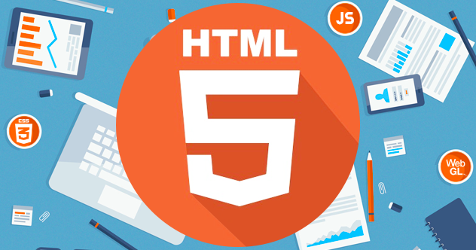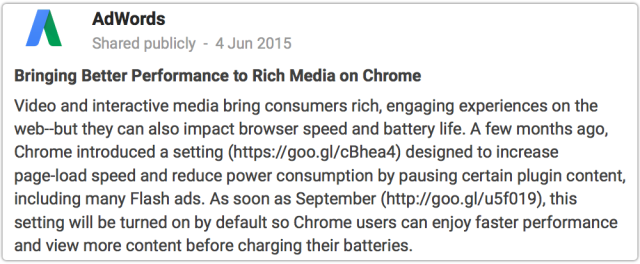Google Chrome will block Flash from tomorrow…well, sort of

Adobe’s Flash will face a double setback tomorrow, 1 September 2015.
Amazon’s outright ban on Flash ads kicks in.
And Google’s Chrome browser will start blocking Flash, too.
Well, sort of.
Like Amazon, Google’s anti-Flash stance is neither altruistic nor security-focused.
Ironically, it’s aimed at making your ad experience better for advertisers, amongst other things, rather than making your browser more secure, though it will no doubt do both.
Google’s original end-of-Flash announcement was headlined Bringing Better Performance to Rich Media on Chrome, and by “performance,” Google was referring to shorter runtimes and lower power usage, rather than to reduced attack surface area:
Video and interactive media bring consumers rich, engaging experiences on the web – but they can also impact browser speed and battery life… As soon as September, this setting will be turned on by default so Chrome users can enjoy faster performance and view more content before charging their batteries.
It’s not so much to stop you getting owned as to keep you immersed in all those rich, engaging experiences – which, of course, includes seeing lots of lovely ads.
Indeed, Chrome won’t ban Flash altogether tomorrow, or even enable click-to-play by default for everything.
But click-to-play will kick in automatically from tomorrow, it seems, for what Google calls “content that’s peripheral to the main page.”
In other words, games and videos that rely on Flash ought still to work, but ads and suchlike probably won’t.
Given that the Google switchover is accompanied by a ban on Flash ads served via AdWords, it’s a pity that Google didn’t go all the way and simply turn on click-to-play altogether by default in Chrome, or even set Flash off by default.
→ There’s an important difference between Ask to Activate Flash and Never Activate, to borrow Mozilla’s terminology. With Ask to Activate, or click-to-play, websites are told that your browser supports Flash, so most servers then use it in preference to HTML5. This produces a click-to-play prompt that understandably convinces many users that Flash is still not only widespread but also necessary. Perhaps a “Reload this page without Flash” option would be a handy way of getting past that hurdle?
Nevertheless, with Google automtically converting AdWords ads to HTML5 where it can, and blocking Flash ads where it can’t, even Flashophiles may start to accept that there really is life beyond Flash.
So, perhaps Google’s change, along with Amazon’s, will help to get us to a point at which Adobe can realistically do what Facebook’s CSO rather peremptorily suggested, and announce an end-of-life date for Flash.
It can’t be much fun maintaining Flash any more.
While we’re about it, and taking into account the abovementioned anti-Flash rant from Facebook’s CSO, it would be great to see the social networking giant following the lead of Amazon and Google, and dropping Flash from Facebook altogether.
Even if the motivation is to get more ads in front of us, having one less plugin to patch would surely help.
Article source: http://feedproxy.google.com/~r/nakedsecurity/~3/AjpwSGAgZ_E/
